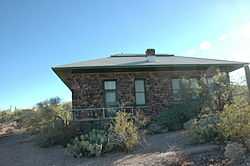Desert Laboratory
|
Desert Laboratory — aka: Desert Botanical Laboratory; Tumamoc Hill; Tumamoc: People & Habitats | |
 | |
 | |
| Nearest city | 1675 West Anklam Road, Tucson, Arizona |
|---|---|
| Coordinates | 32°13′31″N 111°0′9″W / 32.22528°N 111.00250°WCoordinates: 32°13′31″N 111°0′9″W / 32.22528°N 111.00250°W |
| Area | 860 acres (3.5 km2) |
| Built | 1903 |
| Governing body | State |
| NRHP Reference # | 66000190 |
| Significant dates | |
| Added to NRHP | October 15, 1966[1] |
| Designated NHL | December 21, 1965[2] |
The Desert Laboratory at 1675 West Anklam Road, Tucson, Arizona was founded by the Carnegie Institution in 1903 to study how plants survive and thrive in the heat and aridity of deserts. Beginning in 1906, numerous long term ecological observation areas were set up by Volney Spalding & Forrest Shreve on the 860 acres (3.5 km2) scientific domain of Tumamoc Hill. Nine of these are the world's oldest permanent ecology study quadrats. The facility and staff were key contributors to what is now considered the science of ecology, including participating in the creation of the Ecological Society of America in 1915 and the Ecology journal.[3] Led by Spalding & Shreve, they also contributed innovations in conservation.
Part of it was declared a National Historic Landmark in 1965.,[2][4] The rest was added in 1987.
History
Acting on the authority of the Carnegie Institution of Washington, Frederick Vernon Coville Botanist of the USDA and Daniel T. McDougal of the New York Botanical Garden chose Tumamoc Hill as the location of the Desert Laboratory in February, 1903. It opened in October of that year.
It is now operated by Tumamoc: People & Habitats, part of The University of Arizona's College of Science.
Directors
Its current director is Michael Rosenzweig[5]
Walking up Tumamoc's Road
The public is welcome to walk up almost to the top of Tumamoc Hill except not from 7:30 AM to 5:30 PM, Mon-Fri. Walkers must stay on the road. Bicycles and pets are not allowed. And the very top of the Hill is an archaeological site where there is no unsupervised entry. Vehicular traffic restricted to authorized persons.
References
- ↑ "National Register Information System". National Register of Historic Places. National Park Service. 2007-01-23.
- ↑ 2.0 2.1 ResourceId=102&ResourceType=Building "Desert Laboratory". National Historic Landmark summary listing. National Park Service. Retrieved 2007-09-27.
- ↑ Research at Tumamoc
- ↑ Ann Huston (September 1986) National Register of Historic Places Inventory-Nomination: Desert Laboratory of the Carnegie Institution / Tumamoc Hill, National Park Service and Accompanying 8 photos, exterior, from 1986.
- ↑ Desert Laboratory Director Honored by Ecological Society of America
"Discovering the Desert: The Legacy of the Carnegie Desert Botanical Laboratory" by William G. McGinnies, 276 pp, 1981 ISBN 978-0-8165-0728-3
External links
| Wikisource has the text of the 1920 Encyclopedia Americana article Carnegie Desert Laboratory. |
- Official Site
- Desert Laboratory Repeat Photography Collection
- NYtimes article about the creation of the laboratory
- JSTOR article
- Harpers Magazine 1911 article (subscribers only)
| ||||||||||||||||||||||||||